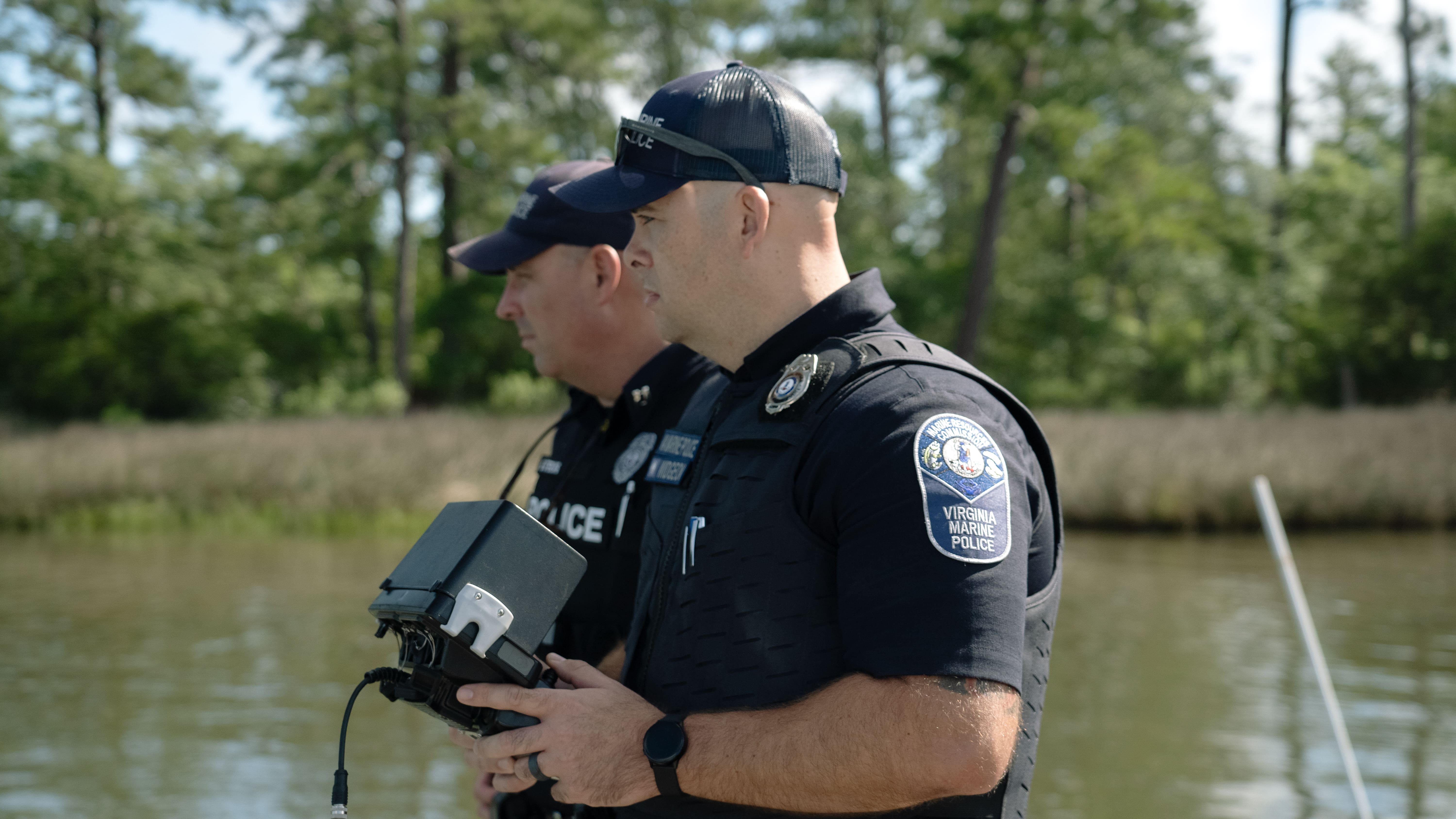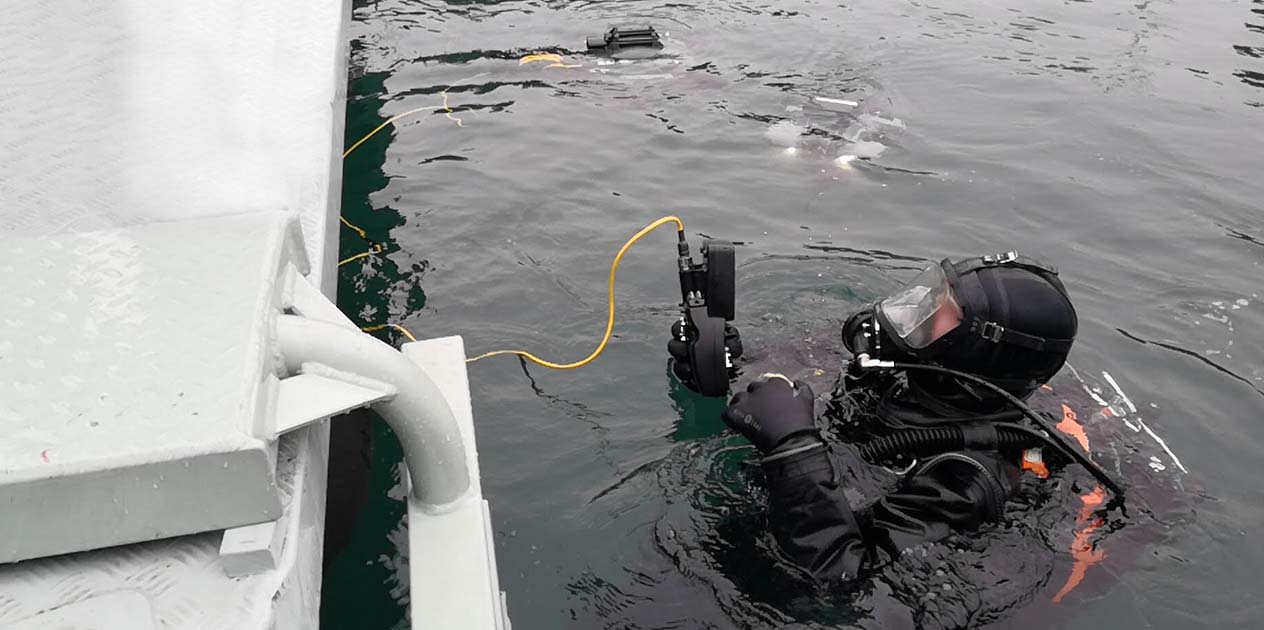Configure Now
Items in Your Cart0
0Items in Your Cart
Start building your packageShop Now
Murky water search and recovery refers to locating and retrieving objects, evidence, or individuals in bodies of water that have low visibility or turbid conditions. The term "murky water" refers to water that is cloudy, muddy, or otherwise obstructed, making it difficult to see clearly underwater.
Murky water is inherently dangerous to navigate through. Below the surface, visibility can range from a few feet to mere inches away, and in some cases, the water is so dark, or dense with particulates, you would not be able to see your hand, even millimeters from your face.
In conditions where visibility is dangerously low, murky water search & rescue operations are extremely difficult to perform. As it is impossible to ascertain the parameters of the dive area, safety becomes a greater concern for divers facing unknown and potentially threatening conditions.
Murky water searches are typically conducted by specially trained divers that use a range of equipment, including:
These types of missions are typically conducted by professional search and recovery teams, such as police, fire, first responders, or organizations specializing in underwater recoveries. The primary objective of these operations is to locate and recover missing persons, evidence or objects related to investigations such as weapons or contraband, or other incidents that occurred in bodies of water with poor visibility.

Search and rescue, and search and recovery missions can be incredibly complex and difficult, especially when working in murky water conditions. Teams face a range of challenges, including, but not limited to:
Low visibility environments can be extremely dangerous to navigate within, often making it impossible to ascertain parameters for the dive and leaving divers to rely on touch to locate the target. This creates a high risk for the divers since they are not able to avoid unknown objects that could entangle them and trap them underwater, or cause injury.
“One of our biggest problems is that, if a person is missing underwater, our divers go in and search but sometimes the areas they go into are too dangerous and we can’t commit divers in dangerous areas,” said LMSRS (Limerick Marine Search and Rescue Service) treasurer Mal Sherlock.
Divers also have a limited amount of time they are able to remain underwater, as well as a limited depth they are able to search in. Working in murky water requires meticulous and systematic search techniques, which means inspections must be conducted slowly and methodically, searching small areas at a time.
The limited bottom time also results in low search accuracy, puts added stress on the divers, and is physically demanding, making these missions even more emotionally and mentally taxing.

This process is repeated until the mission is complete, since divers have a limited depth they can reach and limited amount of time they can spend below the water before it becomes even more dangerous for them.
Depending on the water temperature and other external, or environmental factors such as weather, divers can be extremely limited in their time under the water. If they are under for longer periods of time, the divers are at risk of serious health concerns such as hypothermia or decompression sickness. With the lack of clear visual reference points, they are also not able to establish direction and distances to objects of interest, which increases the risk of disorientation and becoming lost in the search area.
Ensuring the safety of the divers is paramount in search and recovery missions, which is why it’s so important to find alternative methods that are safer and more efficient for everyone. The use of ROVs to aid the divers is currently the best proven option available for these operations.
Technological advancements have made search and recovery missions much safer and more effective than ever before. Though the human eye cannot see through murky water, technology is providing individuals the ability to navigate and identify targets in low to zero visibility environments.

The utilization of this technology has proven to be of immediate benefit to search and recovery teams. In outfitting themselves with navigational sonar systems, for example, first responders and volunteer search and rescue organizations have begun to see the benefit of this cutting edge technology. Sonar has granted greater success rates in finding lost or discarded targets, and the execution of safe and effective recovery missions.
Mr. Sherlock of LMSRS explains how their Deep Trekker ROV, equipped with sonar, is the ideal solution in low visibility environments. “What the unit does is actually phenomenal, and because we deal mostly in zero visibility, the sonar facility on the drone is able to cast a shadow across the seabed and we can decipher on what we are looking at by breaking down elements of the shadow.”
Side scan sonar systems, for instance, are generally towed behind boats to conduct a sweep of a large body of water, or attached to the hull. The entire area would be divided into a search grid. The side scan would then be dragged throughout the entire grid and each area would be checked twice to ensure that the location has been completely explored.
Once the side scan has completed its sweep of the area, search and recovery teams are able to mark areas of interest where their target may be located. Traditionally, divers are deployed at this point and must navigate through the murky water and hope to come across their object of interest. With zero visibility, these divers must rely on touch to move around and to locate their target, which is a very slow and arduous process.
“When we are diving we may miss something alongside us that might be only three feet away, whereas this drone is breaking down that barrier of misses,” Mr Sherlock explained.
There are many common patterns that search teams use to ensure they are thoroughly searching an area. Learn about how underwater ROVs assist in the process.
In a murky water search, the standard camera on the underwater drone will work similar to a human eye; it will struggle with visibility. This is where the multibeam imaging sonar systems come into play. From the surface, the ROV pilot navigates through the low visibility water solely using the sonar's heads up display (HUD), similar to how a pilot would rely on their plane's instruments when they fly through a fog.
Pilots can also track the location of the ROV in real time using USBL positioning systems, and maneuver with precision in difficult areas using DVL stabilization and station holding. Deep Trekker ROVs also include an intuitive mission planner that allows operators to input waypoints to plan and map out a mission route, or to create a path for the ROV to follow autonomously, enabling operators to put their focus solely on the sonar scan and search.

Once the underwater drone successfully identifies the target, divers are able to follow the ROV's tether directly to the target and prepare it for retrieval. If the location is a crime scene, the ROV can record and document the area to assist in the investigation. Most importantly, the diver's safety can be closely monitored from the surface while the retrieval is being conducted.
Leveraging technology and tools such as sonar and ROVs is the best way to avoid unforeseen dangers and guarantee a safe and effective execution of recovery strategy that keeps divers safe and improves the efficiency and success rates of finding targets on these difficult missions.
The Deep Trekker DTG3, PIVOT, and REVOLUTION ROVs are designed to be a truly portable solution. This is made possible by the internal rechargeable batteries, allowing the entire DTG3 package to fit into one carrying case, and the Pivot and Revolution in just two carrying cases.
The DTG3 is battery-operated and portable which provides search teams the ability to work beyond what a normal diver would be able to do. A 90-minute recharge is all it needs to be back and ready for another day's work. This drastically increases possible search times far beyond what would be capable using divers and traditional methods, since divers only have a finite amount of time they can spend underwater.
Portability of ROVs is extremely important during a search and recovery mission. With bodies of water being located in some of the most remote areas on the planet, air transportation or on foot travel may be the only access. Since the Deep Trekker DTG3 is housed in a single Pelican carrying case, it can be transported and deployed easily in isolated areas.

Deep Trekker underwater drones are capable of being equipped with a grabber arm to pick up a submerged target and retrieve it to the surface, or they can attach a carabiner and rope with the grabber arm if the target is not able to be picked up directly.
Having the right tools for the job is crucial, and Deep Trekker ROVs are designed for versatility with modular integrations and customization options to meet your specific mission requirements. Deep Trekker’s BRIDGE Software enables fully integrated solutions for add-ons such as imaging sonars, positioning systems, and more all in one place.
ROVs combined with imaging sonar systems are some of the most beneficial tools for search and recovery missions in murky waters, allowing for visualization of environments that would not be possible without using this technology. With the revolving head of the Deep Trekker REVOLUTION ROV, pilots can even adjust the pitch of the sonar, making scanning areas even easier and more thorough.

Large submersibles and rescue tools can be extremely expensive and can require a lot of set up time. Many of these expenses can be replaced with a single ROV purchase, and maintenance costs of Deep Trekker robots have proven to be very low to non-existent, even after years of use.
This allows teams to allocate their budget in more productive ways, as well as allowing them to utilize their time more efficiently, freeing up more time to conduct the actual searches as quickly as possible.
Also, with extended depth capabilities, Deep Trekker ROVs can search larger areas faster than what is possible using dive teams. This allows search and recovery teams to complete missions much faster and more thoroughly, and with higher success rates than conducting searches with traditional methods.
The proven cost-effectiveness and time-saving benefits of using Deep Trekker ROVs compared to traditional methods makes them the perfect complement to first responder teams working in murky water.
Deep Trekker ROVs are engineered to be tough enough to survive harsh underwater conditions and deliver dramatic power, enhanced capabilities, and performance. Modular integrations such as multibeam imaging sonar, USBL positioning systems, and DVL stabilization and station holding take those capabilities even further, making them must have tools for search and recovery missions.
If you need help finding the right technology for your missions, reach out to our robotics experts to find the right option for your applications and budget. We are happy to help. Get your custom quote today.
November 3rd, 2025
At REPMUS 2025, Deep Trekker’s ROVs validated real-world mine countermeasure capabilities...
July 5th, 2025
Deep Trekker’s new Tampa facility brings faster ROV repairs, in-stock parts,...
June 11th, 2025
Equipped with sonar and DVL, Deep Trekker ROVs are helping SES...